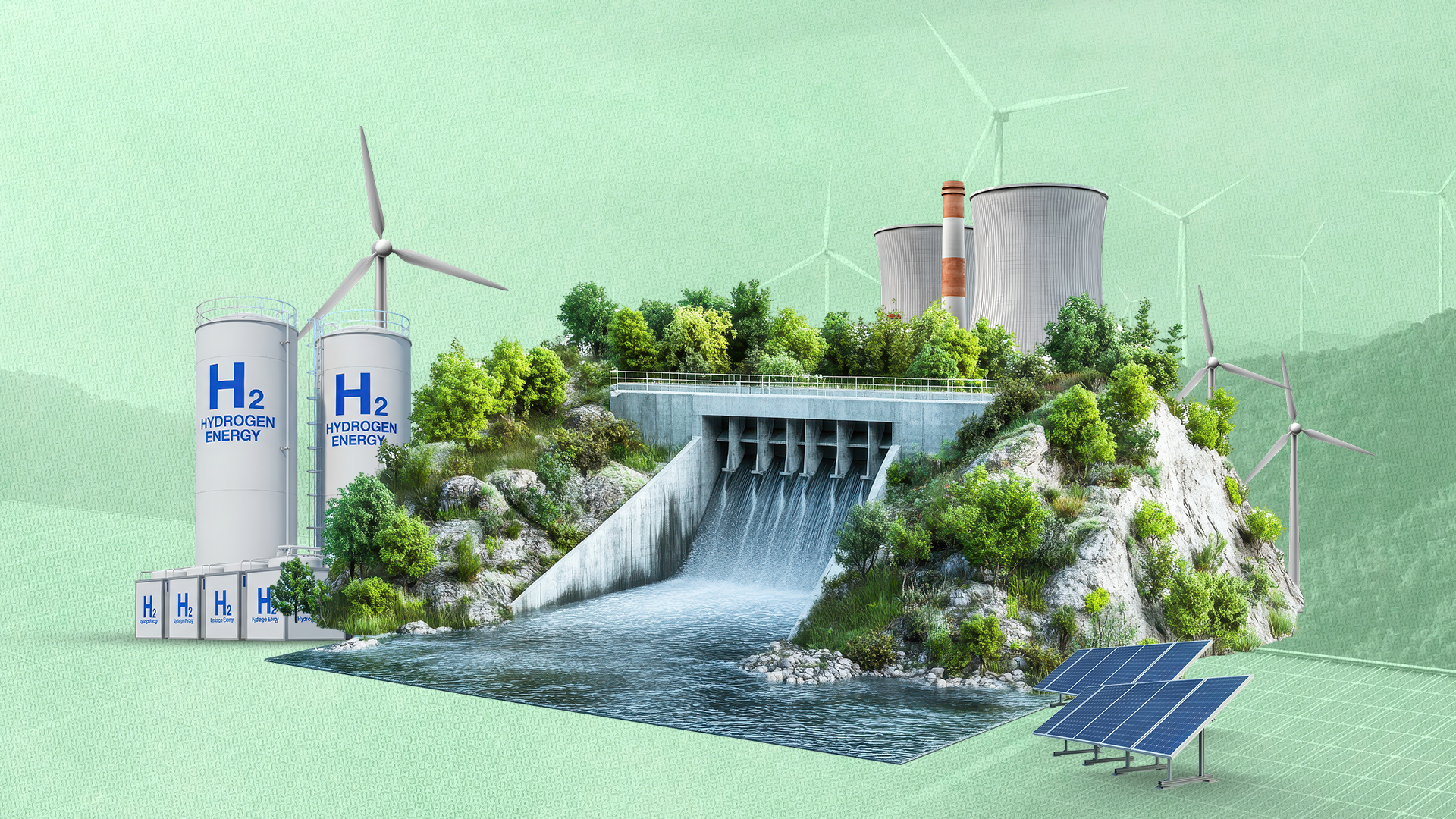In the renewable energy sector, smart capital is driven by three key factors: scale, long-term demand, and a stable policy environment. Few countries globally offer this powerful combination at the scale India does today. That is precisely why India is starting to feature prominently on the radar of global green energy players.
This shift has little to do with headline-grabbing announcements and everything to do with the implementation of transformative government green energy schemes across India. The country has rapidly expanded its renewable capacity, reinforced its policy framework, and unlocked opportunities for large-scale, sustainable investments. India recently achieved a new milestone with its total renewable energy capacity, including large hydro and nuclear power, reaching 256 GW, further demonstrating the effectiveness of the country's renewable efforts.[1]
From massive solar parks in Gujarat to an ambitious green hydrogen mission along the coasts, India's momentum in the green energy is visible. It isn't a question of whether global companies are paying attention — many already are. The real question for investors is whether they are positioned to seize this growth at the right moment. Let's explore the reasons why India is among the most attractive destinations for clean energy investment and where investors should consider aligning their portfolios with sustainable growth.
India's perfect positioning for green energy investments
India combines the key ingredients that global investors seek — scale, demand, and clear policy direction. As one of the world's fastest-growing energy markets, India's renewable energy investments are driven not only by environmental goals but also by the fundamental need to meet rising energy demand sustainably.
The government has laid out an ambitious clean energy roadmap, targeting 500 GW of non-fossil fuel capacity by 2030.[2] To support this, several initiatives are already in place:
- The National Green Hydrogen Mission, launched in 2023, aims to make India a global hub for hydrogen production. It targets an annual production of 5 MMT of green hydrogen by 2030. The mission has an outlay of over ₹ 19,744 crore[3] to facilitate the production, distribution, utilisation and export of hydrogen globally. It positions India to achieve a $8 billion green hydrogen market by 2030 and $340 billion by 2050.[4] The SIGHT program (Strategic Interventions for Green Hydrogen Transition) offers financial incentives for manufacturing electrolysers and producing green hydrogen.[5]
- The Production Linked Incentive (PLI) scheme has been launched to promote the manufacturing of solar modules and batteries. Under the scheme, the government launched the National Programme on High Efficiency Solar PV Modules to promote solar PV manufacturing in India with an outlay of over ₹4,500 crore.[6] Under the scheme, 11 companies have been allocated the total domestic solar PV module manufacturing capacity of 39,600 MW.[7]
- To further promote green energy-related manufacturing initiatives, the government is allowing 100% FDI in renewable energy within India under the automatic route, further helping global investors and enterprises.[8] Thanks to a liberalised FDI regime, foreign investment in non-conventional energy sources has been increasing year-on-year, reaching $12.67 Bn as on March 31, 2025.[9]
- India is strengthening its position through key international collaborations, which began with the launch of the International Solar Alliance, in partnership with France. The European Union (EU) remains one of India's closest partners in this space. The third phase of the India-EU Clean Energy and Climate Partnership[10] is already underway, focusing on enhancing green hydrogen production — a critical component of the clean energy transition. Through the India-Australia Renewable Energy Partnership, the countries will collaborate on a range of renewable energy-related areas, including green hydrogen, solar photovoltaics, capacity building, and more.[11] India is also a founding member of the Global Biofuel Alliance with the US, UAE and Brazil.[12]
This policy stability, combined with a growing domestic energy market and export opportunities, is transforming India into a dependable destination for long-term green energy investment.
Presence of large-scale green energy projects
India's renewable energy ambitions are transforming into substantial, large-scale projects that are already drawing global attention. These initiatives showcase the country's capacity to execute projects at scale, develop long-term infrastructure, and open up investment opportunities across diverse regions and technologies. Some of the most notable initiatives currently underway include:
Rajasthan and Gujarat's solar parks
The two western Indian states continue to lead India's solar expansion initiatives. Through projects like the Bhadla solar park with a capacity of over 2,000 MW,[13] India continues to demonstrate its dedication to renewable energy initiatives. The upcoming Khadva Solar Park, being developed in collaboration with Adani Power, is already operational and expected to be the world's largest solar energy project after completion.[14] Projects like these not only increase renewable generation but also present clear investment opportunities in associated infrastructure and services.
Ladakh's Green Energy Corridor
The government is developing Ladakh as a strategic renewable energy corridor, which includes setting up 13 GW of renewable power and a 12,000 MWh Battery Energy Storage System (BESS).[15] The project is anticipated to be completed by FY 2029-30. The region's ambitious solar and transmission projects aim to supply clean power across the northern grid, supported by investments from central and state governments.
Green Hydrogen initiatives across key states
The coastal states of India are poised to gain the most from India's green hydrogen corridors, and their efforts reflect this. They have active policy incentives, abundant land resources, and well-developed port infrastructure essential for producing, utilising, and exporting hydrogen. These states are already attracting major domestic and international energy players. Ports like Kandla are also developing electrolysers for hydrogen to ensure they produce green hydrogen ready![16]
Public-sector partnerships
Public-private partnerships are a consistent feature across these initiatives, with India's private sector playing an active role as both a participant and investor in renewable energy generation and distribution. These large Indian conglomerates are collaborating with global energy firms and government agencies to drive the next generation of clean energy investments and their subsequent infrastructure. For instance, the India H2 Alliance (IH2A) is one such example. It is building India's hydrogen value chain to reduce carbon emissions and promote green hydrogen.[17] For investors, these projects offer entry points into new segments backed by long-term policy support and visible project pipelines.
How investors can benefit from India's green energy push
India's clean energy sector has moved beyond early-stage growth and is now firmly positioned as a major investment destination. The country offers scalable opportunities across:
- Solar and wind energy investments in India have achieved great success, and the country ranks 4th globally in installed renewable capacity, targeting 500 GW of non-fossil fuel capacity by 2030[18]
- Green Hydrogen, backed by a ₹19,744 crore (approx. $2.3 billion) National Green Hydrogen Mission, aimed at making India a global hub for production and export[19]
- Battery Storage and Grid Modernisation, with recent government tenders for 4,000 MWh of battery storage capacity, is a key step towards renewable grid stability[20]
This momentum is already visible in the actions of global investors. Brookfield Renewable has announced plans to invest up to $1 billion in Avaada Group for the manufacturing of Green Hydrogen, solar PV modules and the growth of a Renewable Energy platform.[21] British International Investment has marked its foray into India's solar manufacturing industry through an investment of over $100 million into ReNew Power.[22] India's Oil and Natural Gas Corporation Limited (ONGC), in conjunction with National Thermal Power Corporation (NTPC), acquired a 100% stake in Ayana Renewables for $2.3 billion, marking a significant shift in the growth trajectory for these energy companies.[23]
Commitments such as these demonstrate increasing confidence in the market's long-term prospects.
India offers the ideal conditions for investors committed to sustainable growth, thanks to its large-scale demand, clear policy guidance, and visible project pipelines. It will require $400 billion in financing to realise its 500 GW target of renewable energy by 2030.[24] This is the right time to make a move in India's renewable energy sector.
The fundamentals are solid and supported by real, verifiable progress on the ground rather than mere promises on paper. With expanding global partnerships and set domestic targets, India's renewable energy sector is steadily creating the kind of long-term opportunities that align with both financial and environmental goals of becoming a net-zero economy by 2070. Learn more about renewable energy investments by visiting investindia.gov.in.

